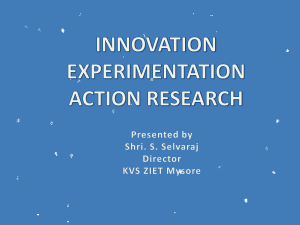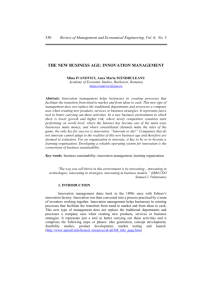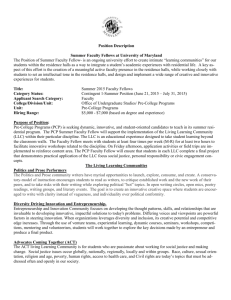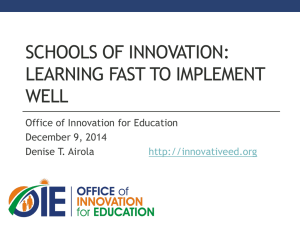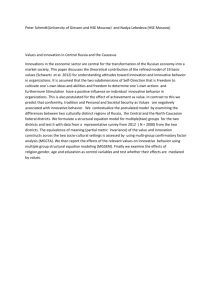Innovation - Tecker International Consulting
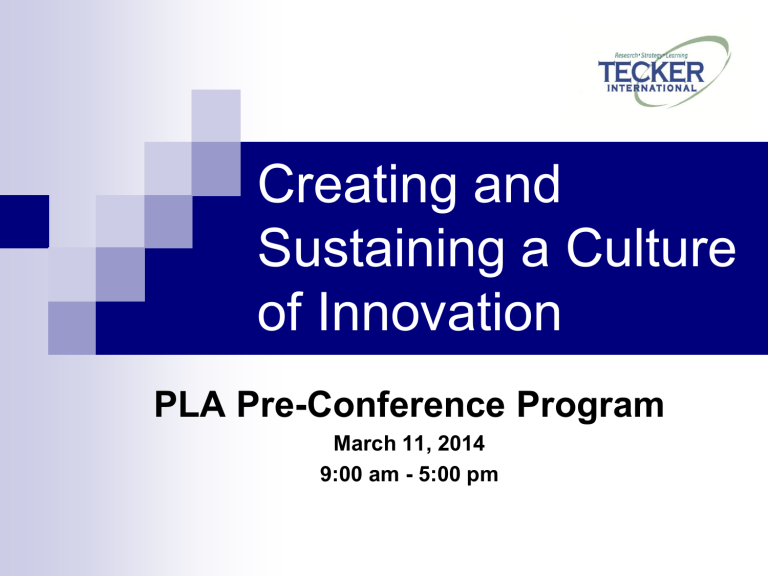
Creating and
Sustaining a Culture of Innovation
PLA Pre-Conference Program
March 11, 2014
9:00 am - 5:00 pm
Copyright 2014 by Tecker International, LLC
-All Rights Reserved-
These materials were specially prepared for instructional use by Tecker International, LLC. No portion of these materials, in whole or in part, may be used in any fashion, or reproduced by any means, without the written permission of
Tecker International, LLC.
For useful information, case studies and valuable links … Please visit our website:
www.tecker.com
Session Agenda
9:00 am – 5:30 pm
Intro to Innovative Culture
Common Definitions
Overview of Innovative Process
Characteristics of an Innovative Culture
Assessment Tool: Creating a Baseline
Creating a Vision for the Future
Break
Reshaping Your Library’s Culture
Lunch: 12:00 – 2:00 p.m.
Continue with Reshaping Your Library’s Culture
Who are you listening to?
How do you change your culture?
Innovation Tools
Future Trends
Exercise: Innovate a process or product
Share Ideas
Assessing Readiness for Change
Why Innovation?
“An established company which in an age demanding innovation, is not able to innovate, is doomed to decline and extinction.”
Peter Drucker
Why Innovation?
Trends tell us…
Increased commoditization results in customer service and innovation becoming primary differentiators.
Global competition is exploding.
Change is happening at a more rapid pace.
“Do more with less.”
New and disruptive technologies will continue.
Definitions
Innovation [ verb ]: The process by which an idea or invention is translated into an improvement in a product, activity or service that increases its value or utility.
Innovation [ noun ]: A positive significant change that improves the effectiveness or efficiency of a structure, process, product, program or idea.
Experimentation : What a library needs to be willing and able to do to innovate.
“Innovation”: A Business Definition
The process by which an idea or invention is translated into a good or service for which people will pay , or something that results from this process.
To be called an innovation, an idea must be replicable at an economical cost and must satisfy a specific need. Innovation involves deliberate application of information , imagination, and initiative in deriving greater or different value from resources , and encompasses all processes by which new ideas are generated and converted into useful products . In business , innovation often results from the application of a scientific or technical idea in decreasing the gap between the needs or expectations of the customers and the performance of a company's products. In a social context , innovation is equally important in devising new collaborative methods such as alliance creation, joint venturing, flexible working hours , and in creating buyers ‘ purchasing power through methods such as layaway plans .
Innovations are divided into two broad categories:
(1) Evolutionary innovations are brought about by numerous incremental advances in technology or processes and are of two types (a) Continuous evolutionary innovations result in an alteration in product characteristics instead of in a new product, and do not require any user-learning or changes in his or her routine .
Examples are the multi-blade shaving razor, fluoride toothpaste, and laptop computers . ( b ) Dynamic continuous evolutionary innovations require some user-learning but do not disrupts his or her routine. Examples are fax machines , instant photography, and handheld computers .
(2) Revolutionary innovations (also called discontinuous innovations ) require a good deal of user-learning, often disrupt his or her routine, and may even require new behavior patterns . Examples are photocopier (xerography) machines, personal computers , and the Internet . Innovation is synonymous with risk-taking and organizations that introduce revolutionary products or technologies take on the greatest risk because they have to create new markets . A less risky innovation strategy is that of the imitator who starts with a new product (usually created by a revolutionary-innovator) having a large and growing demand . The imitator then proceeds to satisfy that demand better with a more effective approach. Examples are IBM with its PC against Apple Computer, Compaq with its cheaper PCs against IBM, and Dell with its stillcheaper clones ( sold directly to the customer) against Compaq. Although many innovations are created from inventions , it is possible to innovate without inventing, and to invent without innovating.
From www.businessdictionary.com/definition/innovation.html
Difference Between Creativity and
Innovation
"Creativity is thinking up new things.
Innovation is doing new things.”
Theodore Levitt
Culture
Culture : a set of shared beliefs, values, attitudes, behaviors and practices that characterize an organization.
External
Forces
Trends
Economy
Demographics
Government
Perceptions
At this point, how innovative would you say is the culture of your library?
Very
Some what
Very little
Hardly at all
Historical Forces
Politics
Norms
Behaviors
“How we have always done things”
Internal Forces
Staff
Volunteers
Process
Procedures
Customers
Leadership
Values
Beliefs
Behaviors
Organizational Culture
Informal Structures
Informal leadership Processes
Performance/Outcomes
Attitudes
Productivity
Hiring
Allocation of Resources
Copyright 2014 by Tecker International LLC
Ten Priorities for Innovation Success
Innovation is connected to long-term strategic direction.
Organizational culture values experimentation and risk-taking and expects some failures.
Organization provides a system-wide process for innovation.
Management supports and rewards innovation.
Resources are available for research and development and experimentation.
Ten Priorities for Innovation Success
Staff has time to innovate.
Brainstorming is a priority and is practiced regularly.
Teamwork across silos, experience, and demographics is practiced.
A formal process of analysis is in place.
Innovation is imbedded into the organization’s belief systems rather than just perceived as a passing fad.
Core Purpose: To solve unsolved problems innovatively.
Core Values:
Act with uncompromising honesty and integrity in everything we do.
Satisfy our customers with innovative technology and superior quality, value and service.
Provide our investors an attractive return through sustainable, global growth.
Respect our social and physical environment around the world.
Value and develop our employees' diverse talents, initiative and leadership.
Earn the admiration of all those associated with 3M worldwide.
Future Vision:
3M Technology Advancing Every Company
3M Products Enhancing Every Home
3M Innovation Improving Every Life
A Culture of Innovation
3M Characteristics:
6.
7.
4.
5.
1.
2.
3.
Research and Development – invests generously
Bold Talent – encourages risk-taking and persistence
Diverse Technologies – seeks uncommon connections
Robust Network – shares ideas and practices
Celebrated Experts – reward employees for innovation
Measured Success – creates accountabilities
Customer Connection – unmet and often unarticulated needs
Adapted from “A Culture of Innovation” 3M Brochure http://solutions.3m.com/wps/portal/3M/en_US/3M-
Company/Information/AboutUs/WhoWeAre/
Self Appraisal: Key Characteristics of an Innovative Culture
High Low
6 5 4 3 2 1
Support from top management in words and actions.
6 5 4 3 2 1
Tied to organization’s strategic direction.
6 5 4 3 2 1
6 5 4 3 2 1
6 5 4 3 2 1
Organizational beliefs support risk-taking, failure, and cross-organizational teams.
Empowerment is practiced – employees feel empowered to try new ideas and practice innovation.
Resources are available for innovation – financial (research and development) and staff time.
6 5 4 3 2 1
6 5 4 3 2 1
6 5 4 3 2 1
6 5 4 3 2 1
6 5 4 3 2 1
Inquiry is continually practiced - formal (qualitative and quantitative research) and informal (making observations and taking notes).
“Why?” and “Why Not?” questions are frequently asked.
“Rule breakers” are identified and considered innovators – people who are using the product/service differently.
Linked to employee hiring and evaluation.
Continuous learning is encouraged – employees are encouraged to share ideas and bring new ideas into the organization.
6 5 4 3 2 1
6 5 4 3 2 1
6 5 4 3 2 1
Employee recognition includes innovation.
Customers are asked and involved in creating change.
Innovation process is understood – employees understand how ideas are analyzed, chosen, and implemented .
Visualization
Draw a picture of a mode of transportation that visually represents your library’s current innovative culture.
Visualization
Draw a picture of a mode of transportation that visually represents your library’s future innovative culture.
“Being forward-looking – envisioning exciting possibilities and enlisting others in a shared view of the future – is the attribute that most distinguishes leaders from nonleaders.”
Kouzes and Posner, To Lead, Create a Shared Vision
Harvard Business Review, 2009.
An Envisioned Future
The year is 2020, your users and community value, understand, and utilize the library. Your library is receiving an award for its collective contribution to the community. The award lists the positive characteristics of your community in 2020.
How is your community different as a result of what has been done?
For whom is it different?
What will be the benefit to them?
Best expressed as full sentence statements with the format:
[Beneficiaries]…[verb]…[condition or attribute].
Our library’s envisioned future…
(One sentence)
__________________________________
An Inquisitive Culture
A dynamic, working environment where the peoplefrom the Director to the volunteer value and allow resources and time for intellectual curiosity and exploration that is meaningful and relevant to the organization and its purpose.
An Inquisitive Culture…
Involves stakeholders at all levels in dialogue and problem solving.
Has a high tolerance for people lending a hand in areas where they have an interest, but not necessarily the expertise.
Seeks answers to questions and provides resources to find answers.
Is populated with people skilled at brainstorming, information seeking, and problem solving.
Values people with imagination and intelligence and who know how to have fun with ideas.
Incorporates a variety of stakeholders including outliers.
Finding Opportunities for Innovation
Innovations need to make something better. The best innovations are usually the result of accidental learning, systematic evaluation, or guided inquiry.
Guided inquiry asks some simple questions:
What's going on that could be made better?
What outcomes are not being achieved as well as you want them to be?
What is taking longer than you want it to?
What isn't working as well as you would like it to?
What is somebody else doing that's working that you are not and could do even better?
What of importance has no one found an answer to or figured out how to do?
What needs or opportunities will your community have in the foreseeable future that they may not even yet know?
How can we exploit/fill these vacuum's before anyone else does?
Position within the
Marketplace
Monitoring
Outposts on the Web
External Environment
Relationships with individuals and organizations
Monitoring
Anchors on the Web
Technology/Science
Internal Environment
Staff
Customers
Board
Products, Programs, and Services
Policies and Procedures
Capabilities and Capacity
Demographics
Business/Economic
Climate
Legislation/
Regulation
Politics/Social Values
Internal & External
Environment
Your Evolving Environment
Key Demographic
Trends – Users &
Staff
________________
________________
________________
Key
Business/Economic
Climate Trends
__________________
__________________
__________________
Key Social Value
Trends
_________________
_________________
_________________
Key Legislation/Regulatory
Trends
________________________
________________________
________________________
Your
Library
Other Key Trends
_______________
_______________
_______________
Key Technology/Science
Trends
____________________
____________________
_____________________
©2014 Tecker International, LLC • www.tecker.com
Primary Environmental Factors
What are three-five primary environmental factors?
Share with your tablemates and be prepared to present to full group.
Most Effective Practice:
A Research Agenda
Can be called an agenda, roadmap or plan.
A collaboratively developed plan to capture information and intelligence on present and emerging issues critical to the organization.
Identify critical issues and associated research questions.
Have priorities and calendars to ensure the timely delivery of information needed for decision making.
An Inquisitive Culture – Knowledge Collection Tools
Focus groups
Program
Assessment
Pop-up surveys
Community
Networking
Other?
Connections with other libraries
My Library
__________
__________
__________
__________
Web
Outposts
Staff Idea
Sharing
Customer
Complaints
Customer
Interviews
Qualitative
Telephone
Interviews
An Inquisitive Culture – Knowledge Collection Tools
Current Future
Who?
How?
Who?
How?
Innovative Culture - Staff
Top management support
Seek innovation when recruiting new employees
Alignment with strategic direction – where are we going?
How do we define success?
Value risk-taking and trying new ideas
Provide time for innovation
Reward innovation
Include innovation in job descriptions
Encourage sharing across silos
Encourage sharing from external sources
Other? _____________________________
Questions for Discussion
What one thing am I going to do with staff to encourage innovation?
How can I instutionalize my one thing?
The problem is never how to get new innovative ideas into your mind, but how to get the old ideas out.”
Dee Hock
Practicing…
Increase in
Cyber Attacks
Growth in
Obesity
Future “Mega” Trends
Profound
Generational
Differences
Explosive
Growth in Use of Mobile
Devices
Growth in
Cloud
Computing
Growing
Population of
Immigrant
Children
Shorter
Economic
Cycles
Decrease in
Ownership
Urbanization of
Populations
Your
Library
Other?
___________
Brainstorming
1.
2.
3.
4.
5.
6.
7.
8.
Define the problem as concisely as possible.
Set a time limit (30-60 minutes).
Capture all ideas. Write quickly and use slow periods to link ideas and make connections. No criticism of ideas allowed or self-editing. Laughter is appropriate.
Discuss ideas. Select the 5-8 ideas that the group likes the best.
Identify criteria you will use to select the top idea.
Rate ideas using criteria. Look for possible connections between selected ideas.
Identify the idea with the highest score. Discuss the idea and create group ownership.
Retain all ideas.
Become the Customer
Purpose: To create an in-depth understanding of the challenge/opportunity from the customer’s perspective.
How?
1. Identify your challenge or opportunity.
2. Create an environment to immerse the team into the customer’s experience.
Examples include: meet in the customer’s setting, dress like the customer, role-play situations, interview customers, shadow customers, etc.
3.
Discuss findings focusing on thoughts and feelings as well as physical observations.
4.
Brainstorm prototypes/solutions strictly from the customer’s point of view.
5.
Overlay organizational limitations.
6.
Identify and implement solutions.
Solution Searching
Purpose: To use the ideas/inventions created within another profession/industry to create solutions to your challenge or opportunity.
How?
1.
Brainstorm professions/industries/products that have already created solutions to your challenge.
2.
Pick one or two that best fits.
3.
Increase knowledge of the chosen solution(s) through research, examination, inviting solution representative to speak to group, etc.
4.
Identify the similarities and differences between the outside solutions and your challenge.
5.
Identify how you can respond to your challenge using the outside solution as a model.
6.
Create a plan to implement ideas.
Transcendence
Purpose: To encourage groups to expand thinking beyond the initial challenge or opportunity.
How?
1. Identify the product, service, or process to examine.
2. Identify the primary and secondary solutions the product, service, or is attempting to solve.
3. Eliminate the product, service or process completely.
4. Brainstorm solutions ignoring the current.
5. See if any alternative solutions make more sense than the current solution.
6. Consider creating a new solution or adapting the current solution with your new ideas.
7. Create an action plan to implement new ideas.
Brain Jolt
Purpose: To use analogies and metaphors to force insights into a challenge or opportunity by analyzing a completely different situation and then going back to the challenge or opportunity at hand.
How?
1. Identify the product/service/process to examine.
2. Identify a completely different product/service/process/person to examine and compare.
3. Brainstorm the characteristics/attributes of your identified product/service/process/person.
4. Identify connections between your product/service/process and the unlike item.
5. Identify possible enhancements to your issue.
6. Create an action plan to implement new ideas.
What I am Thinking About
(Write a challenge or situation you are facing. List three critical issues regarding it.)
Actual Results
(List the results you’ve gotten so far regarding your challenge or situation.)
Draw a Picture
(Draw a picture of the results you’d like to achieve in the future.)
Changes in Thinking
(List ways you would need to change your thinking to get your identified future esults.)
Notes:
Drivers
Current
Condition
Restrainers (Barriers)
Envisioned
Future
Assessing the Readiness for Change
Assess your organization’s readiness to make changes that will improve the
“IQ” [ Innovation Quotient ] of its culture.
Please identify the key driving factors (+) that will greatly assist in making the change.
________________________________________________________
________________________________________________________
________________________________________________________
Please identify the major restraining factors (-) that will be significant barriers to making the change.
________________________________________________________
________________________________________________________
________________________________________________________
Copyright 2011 by Tecker International LLC
Three Questions
1.
What are the areas where you want change to occur?
2.
What are the desired changes/outcomes you want to accomplish in each area?
3.
What must be done to achieve the change?
Paul D. Meyer
Paul D. Meyer, is President and Co-CEO of Tecker International, LLC and Primary Consultant for Thunderbolt Thinking, Inc.
Consulting Experience
Paul has worked with large, complex and multi-system organizations as well as small community-based institutions and corporations representing a variety of industries and professions. He has worked with groups in a number of industries/professions such as medical, hospitality, library sciences, construction, travel, engineering, pharmacy, scientific research, association sciences, healthcare, public institutions, insurance/financial services and universities as well as corporations. His primary areas of expertise include strategic planning facilitation, innovation training, and implementation, operational analysis and alignment, structural reengineering, market and marketing research, governance restructuring, branding, and product/program assessments. He is a proven researcher, trainer, and group process facilitator focused on producing results through collaboration, group dialogue, and research assessment. Mr. Meyer’s skills and experience enables him to assist groups at reaching consensus in developing new opportunities, creating innovative solutions, solving problems, and achieving identified organizational goals.
Not-For-Profit Experience
With over 15 years of experience in managing not-for-profit organizations, Paul brings a wealth of knowledge and innovative thinking to his consulting engagements. He has held a variety of positions within organizations developing expertise in organizational strategy, governance, revenue creation, market research, innovation, alliance building, marketing, public relations, knowledge management, branding, chapter relations, customer acquisition, leadership training, international expansion, and new product development. Paul brings specific knowledge of the internal operations of organizations to his consulting engagements.
Education and Professional Involvements
Paul has an MBA from Marymount University. He is an active member of American Society of Association Executives and the Center for
Association Leadership serving on committees, contributing to publications, and speaking at conferences.
Paul has also published articles and led workshops on such topics as strategic planning, corporate branding, marketing, leadership training, market research, new product development, innovation, customer service, and organizational strategy.
pmeyer@tecker.com



